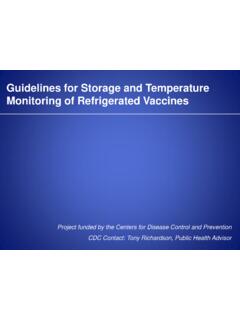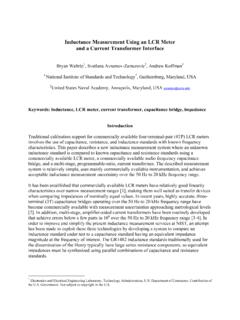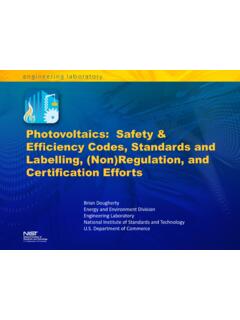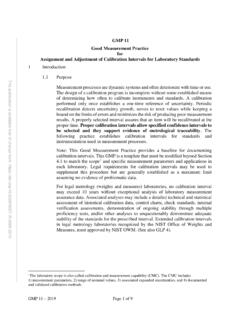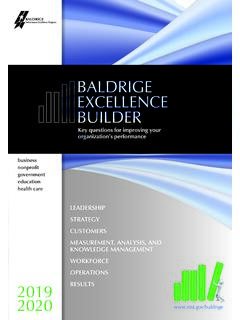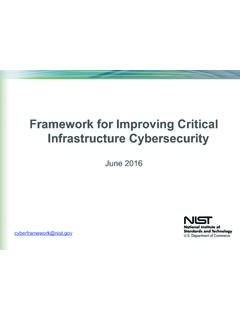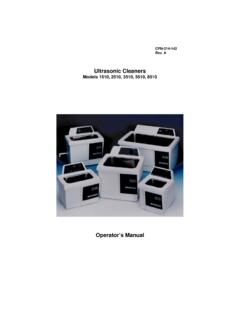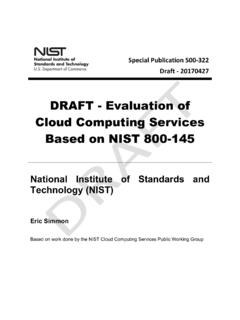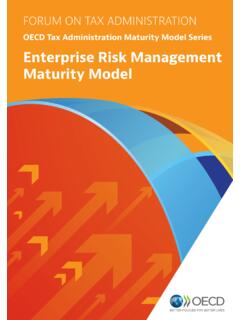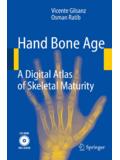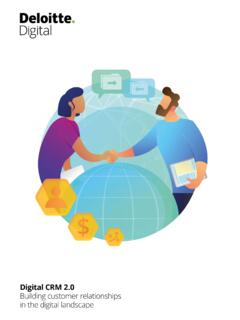Transcription of NIST Privacy Framework: A Tool for Improving Privacy ...
1 Version NIST Privacy FRAMEWORK: A tool FOR Improving Privacy THROUGH ENTERPRISE RISK MANAGEMENT January 16, 2020 The contents of this document do not have the force and effect of law and are not meant to bind the public in any way. NIST Privacy Framework January 16, 2020 i Executive Summary For more than two decades, the Internet and associated information technologies have driven unprecedented innovation, economic value, and improvement in social services. Many of these benefits are fueled by data about individuals that flow through a complex ecosystem.
2 As a result, individuals may not be able to understand the potential consequences for their Privacy as they interact with systems, products, and services. At the same time, organizations may not realize the full extent of these consequences for individuals, for society, or for their enterprises, which can affect their brands, their bottom lines, and their future prospects for growth. Following a transparent, consensus-based process including both private and public stakeholders to produce this voluntary tool , the National Institute of Standards and Technology (NIST) is publishing this Privacy Framework: A tool for Improving Privacy through Enterprise Risk Management ( Privacy Framework), to enable better Privacy engineering practices that support Privacy by design concepts and help organizations protect individuals Privacy .
3 The Privacy Framework can support organizations in: Building customers trust by supporting ethical decision-making in product and service design or deployment that optimizes beneficial uses of data while minimizing adverse consequences for individuals Privacy and society as a whole;1 Fulfilling current compliance obligations, as well as future-proofing products and services to meet these obligations in a changing technological and policy environment; and Facilitating communication about Privacy practices with individuals, business partners, assessors, and regulators. Deriving benefits from data while simultaneously managing risks to individuals Privacy is not well-suited to one-size-fits-all solutions.
4 Like building a house, where homeowners make layout and design choices while relying on a well-engineered foundation, Privacy protection should allow for individual choices, as long as effective Privacy risk mitigations are already engineered into products and services. The Privacy Framework through a risk- and outcome-based approach is flexible enough to address diverse Privacy needs, enable more innovative and effective solutions that can lead to better outcomes for individuals and organizations, and stay current with technology trends, such as artificial intelligence and the Internet of Things.
5 The Privacy Framework follows the structure of the Framework for Improving Critical Infrastructure Cybersecurity (Cybersecurity Framework) [1] to facilitate the use of both frameworks together. Like the Cybersecurity Framework, the Privacy Framework is composed of three parts: Core, Profiles, and Implementation Tiers. Each component reinforces Privacy risk management through the connection between business and mission drivers, organizational roles and responsibilities, and Privacy protection activities. The Core enables a dialogue from the executive level to the implementation/operations level about important Privacy protection activities and desired outcomes.
6 Profiles enable the prioritization of the outcomes and activities that best meet organizational Privacy values, mission or business needs, and risks. 1 There is no objective standard for ethical decision-making; it is grounded in the norms, values, and legal expectations in a given society. NIST Privacy Framework January 16, 2020 ii Implementation Tiers support decision-making and communication about the sufficiency of organizational processes and resources to manage Privacy risk. In summary, the Privacy Framework is intended to help organizations build better Privacy foundations by bringing Privacy risk into parity with their broader enterprise risk portfolio.
7 Acknowledgements This publication is the result of a collaborative effort between NIST and organizational and individual stakeholders in the public and private sectors. In developing the Privacy Framework, NIST has relied upon three public workshops, a request for information (RFI), a request for comment (RFC), five webinars, and hundreds of direct interactions with NIST acknowledges and thanks all of those who have contributed to this publication. 2 A complete development archive can be found at NIST Privacy Framework January 16, 2020 iii Table of Contents Executive Summary.
8 I Acknowledgements ..ii Privacy Framework Introduction ..1 Overview of the Privacy Framework .. 2 Privacy Risk Management .. 2 Cybersecurity and Privacy Risk Management .. 3 Privacy Risk Assessment .. 4 Document Overview .. 5 Privacy Framework Basics ..6 Core .. 6 8 Implementation Tiers .. 8 How to Use the Privacy Framework ..9 Mapping to Informative References .. 9 Strengthening 10 Establishing or Improving a Privacy Program .. 11 Applying to the System Development Life Cycle .. 12 Using within the Data Processing Ecosystem .. 13 Informing Buying Decisions.
9 14 References .. 15 Appendix A: Privacy Framework Core .. 17 Appendix B: Glossary .. 28 Appendix C: Acronyms .. 31 Appendix D: Privacy Risk Management Practices .. 32 Appendix E: Implementation Tiers Definitions .. 37 List of Figures Figure 1: Core, Profiles, and Implementation 2 Figure 2: Cybersecurity and Privacy Risk Relationship .. 3 Figure 3: Relationship Between Privacy Risk and Organizational Risk .. 4 Figure 4: Privacy Framework Core Structure .. 6 Figure 5: Using Functions to Manage Cybersecurity and Privacy 7 Figure 6: Relationship Between Core and Profiles .. 8 Figure 7: Notional Collaboration and Communication Flows Within an Organization.
10 10 Figure 8: Data Processing Ecosystem Relationships .. 13 List of Tables Table 1: Privacy Framework Function and Category Unique Identifiers .. 19 Table 2: Privacy Framework Core .. 20 Table 3: Privacy Engineering and Security Objectives .. 34 NIST Privacy Framework January 16, 2020 1 Privacy Framework Introduction For more than two decades, the Internet and associated information technologies have driven unprecedented innovation, economic value, and access to social services. Many of these benefits are fueled by data about individuals that flow through a complex ecosystem.
